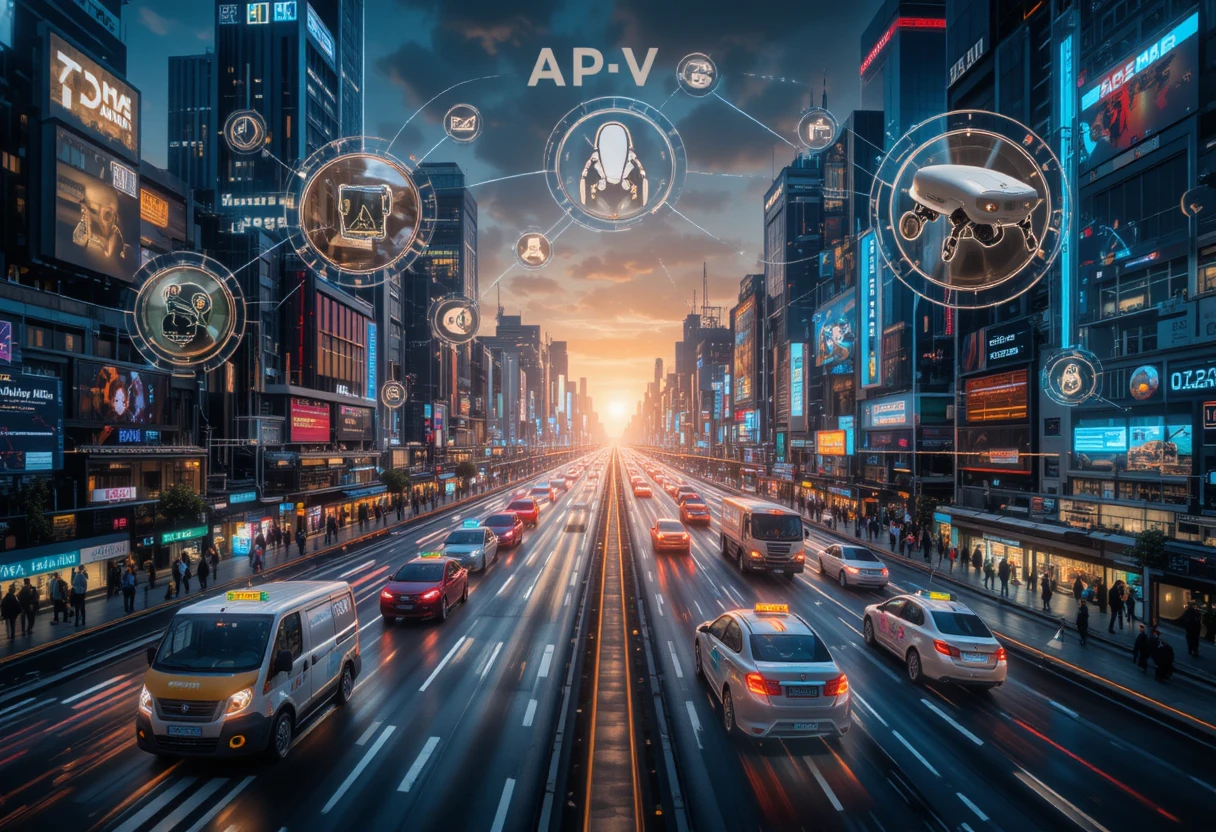Autonomous vehicles (AVs), often referred to as self-driving cars, are revolutionizing transportation by leveraging advanced technologies like artificial intelligence (AI), sensors, and connectivity to operate without human intervention. These vehicles promise to enhance safety, efficiency, and accessibility while transforming industries and urban landscapes. From personal cars to delivery robots, autonomous vehicles are paving the way for a new era of mobility. This 3000-word article explores the fundamentals, applications, challenges, and future of autonomous vehicles, providing a comprehensive overview of their transformative potential.
What are Autonomous Vehicles?
Autonomous vehicles are vehicles capable of navigating and operating without human input, using a combination of sensors, cameras, AI, and communication systems to perceive their environment and make real-time decisions. AVs range from fully autonomous cars requiring no driver to semi-autonomous vehicles with advanced driver-assistance systems (ADAS). The Society of Automotive Engineers (SAE) defines six levels of automation, from Level 0 (no automation) to Level 5 (full automation), with most current AVs operating at Levels 2–3.
A Brief History of Autonomous Vehicles
The concept of self-driving vehicles dates back to the 1920s, with early experiments using radio-controlled cars. In the 1980s, projects like Carnegie Mellon’s Navlab introduced computer vision for navigation. The 2000s saw significant progress with DARPA’s Grand Challenges, which spurred advancements in autonomous driving technology.
The 2010s marked a turning point, with companies like Google (now Waymo) testing self-driving prototypes and Tesla introducing Autopilot, a Level 2+ system. By the 2020s, Waymo, Cruise, and Baidu were operating commercial robotaxi services, while delivery robots and autonomous trucks gained traction. Today, AVs are a multi-billion-dollar industry, with global adoption accelerating.

How Autonomous Vehicles Work: Core Components
Autonomous vehicles rely on a sophisticated integration of hardware, software, and connectivity to navigate and operate safely.
Sensors and Perception
AVs use a suite of sensors to perceive their environment:
- LIDAR: Creates 3D maps using laser pulses for precise distance measurement.
- Radar: Detects objects and measures speed, effective in adverse weather conditions.
- Cameras: Capture visual data for lane detection, traffic sign recognition, and object identification.
- Ultrasonic Sensors: Assist with close-range tasks like parking.
Computing and AI
Onboard computers process sensor data using AI algorithms, such as deep learning, to interpret the environment, predict object behavior, and plan routes. High-performance chips, like NVIDIA’s DRIVE platform, enable real-time decision-making.
Mapping and Localization
High-definition (HD) maps provide detailed road data, while GPS and inertial measurement units (IMUs) ensure precise localization. AVs cross-reference sensor data with maps to navigate accurately.
Connectivity
AVs use vehicle-to-everything (V2X) communication, including vehicle-to-vehicle (V2V) and vehicle-to-infrastructure (V2I), to share data with other vehicles and traffic systems. 5G connectivity ensures low-latency communication for real-time updates.
Control Systems
Control systems, including steering, acceleration, and braking actuators, execute decisions made by the AI. Redundant systems ensure safety in case of failures.
Levels of Autonomy
The SAE defines six levels of vehicle autonomy, guiding development and regulation:
- Level 0 (No Automation): Fully manual driving.
- Level 1 (Driver Assistance): Basic features like cruise control or lane-keeping assist.
- Level 2 (Partial Automation): Advanced systems like Tesla Autopilot, requiring driver supervision.
- Level 3 (Conditional Automation): Vehicles handle most tasks but may require human intervention (e.g., Audi A8’s Traffic Jam Pilot).
- Level 4 (High Automation): Fully autonomous in specific conditions, like Waymo’s robotaxis in designated areas.
- Level 5 (Full Automation): Complete autonomy in all environments, with no human input needed.
Applications of Autonomous Vehicles
AVs are transforming industries and daily life with diverse applications.
Personal Transportation
Self-driving cars, like those from Waymo and Tesla, offer convenient, hands-free travel. They promise to reduce driver fatigue and enable mobility for those unable to drive, such as the elderly or disabled.
Ride-Sharing and Robotaxis
Robotaxi services, operated by Waymo, Cruise, and Baidu, provide autonomous ride-sharing in cities like San Francisco and Beijing. These services reduce costs and improve accessibility compared to traditional taxis.
Delivery and Logistics
Autonomous delivery vehicles, like Nuro’s robots and Amazon’s Scout, transport packages, groceries, and food. Drones complement ground vehicles for last-mile delivery in urban and rural areas.
Public Transportation
Autonomous shuttles, such as those from Navya and EasyMile, operate in campuses, airports, and urban areas, offering low-cost, eco-friendly public transit solutions.
Freight and Trucking
Autonomous trucks, developed by companies like TuSimple and Aurora, streamline freight transport by reducing labor costs and improving efficiency on long-haul routes.
Agriculture
Autonomous tractors and drones, like those from John Deere, perform tasks like planting, harvesting, and crop monitoring, enhancing precision agriculture and reducing labor needs.
Emergency Services
AVs support emergency response by navigating quickly to disaster zones or delivering medical supplies. Autonomous ambulances could provide real-time patient monitoring en route to hospitals.

Benefits of Autonomous Vehicles
AVs offer significant advantages, driving their adoption across sectors.
Enhanced Safety
Human error causes over 90% of traffic accidents. AVs, with precise sensors and AI, can reduce collisions by detecting hazards and reacting faster than humans.
Increased Efficiency
AVs optimize traffic flow, reduce congestion, and improve fuel efficiency through smooth acceleration and route planning. Platooning in autonomous trucks minimizes drag, saving fuel.
Accessibility
AVs enable mobility for individuals unable to drive, such as the disabled or elderly, promoting inclusivity and independence.
Cost Savings
Autonomous delivery and ride-sharing reduce labor costs, while optimized driving lowers fuel and maintenance expenses. Consumers benefit from affordable transport options.
Environmental Impact
Electric AVs, like Tesla’s models, reduce emissions. Optimized routes and traffic management further minimize environmental footprints.
Challenges in Autonomous Vehicles
Despite their potential, AVs face hurdles that must be addressed for widespread adoption.
Technical Limitations
Achieving Level 5 autonomy requires overcoming challenges in complex environments, such as unpredictable weather or crowded urban areas. Sensor reliability and AI robustness need improvement.
Regulatory Frameworks
Global regulations for AVs are inconsistent, with varying standards for testing and deployment. Harmonizing laws and ensuring safety compliance are critical.
Public Acceptance
Skepticism about AV safety, fueled by high-profile accidents like Tesla’s Autopilot crashes, hinders adoption. Transparent testing and education are needed to build trust.
Cybersecurity
AVs are vulnerable to hacking, which could compromise safety or data. Robust encryption and secure V2X communication are essential to prevent attacks.
Infrastructure Integration
AVs require smart infrastructure, like V2I systems and 5G networks, to operate effectively. Upgrading roads and traffic systems is costly and time-consuming.
Ethical Dilemmas
AVs face ethical challenges, such as decision-making in unavoidable accidents (e.g., choosing between pedestrian and passenger safety). Developing ethical AI frameworks is complex.
Ethical Considerations
AVs raise ethical questions that demand careful consideration to balance innovation and societal impact.
Safety and Decision-Making
Programming AVs to handle moral dilemmas, like prioritizing lives in accidents, raises ethical concerns. Transparent algorithms and public input are needed to address these issues.
Privacy
AVs collect vast amounts of data, including location and passenger behavior, raising privacy concerns. Robust data protection and user consent are critical.
Digital Divide
AV adoption may favor affluent regions, exacerbating inequality. Affordable solutions and public transit AVs can bridge this gap.
Environmental Impact
While electric AVs reduce emissions, their production and battery disposal contribute to environmental concerns. Sustainable manufacturing and recycling are essential.

The Future of Autonomous Vehicles
The future of AVs is promising, with emerging trends set to accelerate their impact.
Full Autonomy (Level 5)
Advancements in AI and sensors will enable Level 5 autonomy, allowing AVs to operate in all conditions without human intervention, potentially by the 2030s.
5G and V2X Connectivity
5G’s low latency and high bandwidth will enhance V2X communication, enabling real-time traffic coordination and safer navigation in dense environments.
Urban Air Mobility (UAM)
Autonomous air taxis, like those from Joby Aviation and Volocopter, will complement ground AVs, offering urban transport solutions and reducing congestion.
AI and Machine Learning
AI will improve AV decision-making, enabling better handling of edge cases and unpredictable scenarios. Onboard learning will reduce reliance on cloud processing.
Sustainable AVs
Electric and hydrogen-powered AVs will dominate, supported by renewable energy and eco-friendly manufacturing to minimize environmental impact.
Shared Mobility
The rise of robotaxis and autonomous shuttles will shift transportation toward shared models, reducing car ownership and urban congestion.
Regulatory Harmonization
Global standards for AV testing, safety, and deployment will facilitate widespread adoption, with organizations like the UN working toward unified regulations.
Conclusion
Autonomous vehicles are poised to redefine transportation by enhancing safety, efficiency, and accessibility. Their applications in personal mobility, logistics, agriculture, and beyond demonstrate their transformative potential. However, technical, regulatory, and ethical challenges must be addressed to ensure responsible adoption. As technologies like 5G, AI, and sustainable energy advance, AVs will play a central role in shaping smart, connected cities. Collaboration between innovators, regulators, and society will be crucial to harness the benefits of AVs, creating a future where transportation is safer, greener, and more inclusive.
